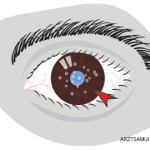NEW YORK (Reuters Health)—Commensal microbes in the gut can activate retina-specific T cells that go on to cause autoimmune uveitis in a mouse model, researchers report.
“These findings allow us to understand the biological basis for the disease,” lead author of the study, Dr. Rachel Caspi from National Eye Institute at the NIH in Bethesda, Md., wrote via email to Reuters Health. “The findings should in no way be interpreted that a patient can pop a probiotic pill and their disease will improve, or that they should start taking antibiotics to eliminate commensal bacteria.”
In order to enter the eye, pathogenic T cells must first be activated, but the target antigens are sequestered in the eye and are not expressed in the periphery. A major unresolved question has been where such retina-specific T cells become activated.
Knowing that T cells can be activated by microbial components in the gut environment, Dr. Caspi’s team used the R161H mouse model of autoimmune uveitis to study natural triggers of the disease.
They found that spontaneous uveitis in these mice is associated with enhancement of IL-17 producing T cells in the gut and that elimination of commensals not only attenuates uveitis but also reduces activation of those T cells in the intestine.
Moreover, activation of these T cells is independent of endogenous interphotoreceptor retinoid-binding protein (IRBP) expression. Rather, the retina-specific T cells in the intestine are activated by signals derived from intestinal microbiota.
Gut microbe-rich protein extracts contain all the stimuli needed to make retina-specific T cells capable of breaching the intact blood-retinal barrier and causing uveitis, according to the report published online Aug. 18 in Immunity.
“Our data uncover for the first time that lymphocytes which recognize self proteins (in our case retinal proteins) can be activated in the intestine through their specific receptors by the commensal bacteria to cause inflammation in the eye,” Dr. Caspi said. “We believe that this could be an under-appreciated mechanism that might underlie other autoimmune diseases.”


